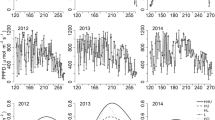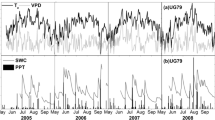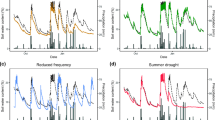Abstract
This study explores the relationship between the normalized difference vegetation index (NDVI), aboveground plant biomass, and ecosystem C fluxes including gross ecosystem production (GEP), ecosystem respiration (ER) and net ecosystem production. We measured NDVI across long-term experimental treatments in wet sedge tundra at the Toolik Lake LTER site, in northern Alaska. Over 13 years, N and P were applied in factorial experiments (N, P and N + P), air temperature was increased using greenhouses with and without N + P fertilizer, and light intensity (photosynthetically active photon flux density) was reduced by 50% using shade cloth. Within each treatment plot, NDVI, aboveground biomass and whole-system CO2 flux measurements were made at the same sampling points during the peak-growing season of 2001. We found that across all treatments, NDVI is correlated with aboveground biomass (r 2=0.84), GEP (r 2=0.75) and ER (r 2=0.71), providing a basis for linking remotely sensed NDVI to aboveground biomass and ecosystem carbon flux.



Similar content being viewed by others
References
Billings WD (1987) Carbon balance of Alaskan tundra and taiga ecosystems: past, present, and future. Q Sci Rev 6:165–177
Bliss LC (1981) Tundra ecosystems: a comparative analysis. Heal OW, Moore JJ (eds) Cambridge University Press, Cambridge
Braswell BH, Schimel DS, Linder E, Moore B III (1997) The response of global terrestrial ecosystems to interannual temperature variability. Science 278:870–872
Bret-Harte MS, Shaver GR, Zoerner JP, Johnstone JF, Wagner JL, Chavez AS, Gunkelman RF IV, Lippert SC, Laundre JA (2001) Developmental plasticity allows Betula nana to dominate tundra subjected to an altered environment. Ecology 82:18–32
Chapin FS III, Shaver GR (1985) Individualistic growth response of tundra plant species to manipulation of light, temperature, and nutrients in a field experiment. Ecology 66:564-576
Chapin FS III, Miller PC, Billings WD, Coyne P (1980) Carbon and nutrient budgets and their control in coastal tundra. In: Brown J, Miller P, Tieszen L, Bunnell F (eds) An Arctic ecosystem: the coastal tundra at Barrow, Alaska. Dowden, Hutchison and Ross, Stroudsburg, Pa., pp 458–482
Chapin FS, Shaver GR, Giblin AE, Nadelhoffer KJ, Laundre JA (1995) Responses of arctic tundra to experimental and observed changes in climate. Ecology 76:694–711
Dorfmann CF, Woodin SJ (2002) Climate change in the Arctic: using plant functional types in a meta-analysis of field experiments. Funct Ecol 16:4–17
Gitelson A, Merzlyak M (1996) Signature analysis of leaf reflectance spectra: algorithm development for remote sensing of chlorophyll. J Plant Physiol 148:495–500
Gorham E (1991) Northern peatlands: role in the carbon cycle and probable responses to climatic warming. Ecol Appl 1:182–195
Gough L, Wookey PA, Shaver GR (2002) Dry heath arctic tundra responses to long-term nutrient and light manipulation. Arct Antarct Alp Res 34:211–218
Goward SN, Tucker CJ, Dye DG (1985) North American vegetation patterns observed with the NOAA-7 advanced very high resolution radiometer. Vegetation 64:3–14
Hamilton TD (1986) Late Cenozoic glaciation of the Central Brooks Range. In: Hamilton TD, Reed KM, Thorson RM (eds) Glaciation in Alaska: the geologic record. Alaska Geological Society, Anchorage, pp 9–49
Henry GHR, Freedman B, Svoboda J (1986) Effects of fertilization on three tundra plant communities of a polar desert oasis. Can J Bot 64:2502–2507
Hobbie JE, Deegan LA, Peterson BJ, Rastetter EB, Shaver GR, Kling GW, O'Brien WJ, Chapin FS, Miller MC, Kipphut GW, Bowden WB, Hershey AE, McDonald ME (1994.) Long-term measurements at the arctic LTER site. In: Powell TM, Steele JH (eds) Ecological time series. Chapman and Hall, New York, pp 391–409
Hope AS, Kimball JS, Stow DA (1993) The relationship between tussock tundra spectral reflectance properties and biomass and vegetation composition. Int J Remote Sensing 14:1861–1874
Johnson L, Shaver, GR, Cades D, Rastetter EB, Nadelhoffer KJ, Giblin AE, Laundre J, Stanley A (2000) Carbon-nutrient interactions control CO2 exchange in Alaskan wet sedge ecosystems. Ecology 81:453–469
Jonasson S, Lee JA, Callaghan TV, Havstrom M, Parsons A (1996) Direct and indirect effects of increasing temperatures on subarctic ecosystems. In: Karlsson PS, Callaghan TV (eds) Plant Ecology in the Subarctic Swedish Lapland. Ecol Bull 45:180–191
Jonasson S, Michelsen A, Schmidt IK, Nielsen EV (1999) Responses in microbes and plants to changes in temperature, nutrient and light regimes in the Arctic. Ecology 80:1828–1843
Keyser AR, Kimball JS, Newmani RR, Running SW (2000) Simulating the effects of climate change on the carbon balance of North American high-latitudes forests. Global Change Biol 6:185–195
Kumar M, Monteith JL (1981) Remote sensing of crop growth. In: Smith (ed) Plants and the daylight spectrum. Academic Press, London, pp 133–144
Maxwell B (1992) Arctic climate: potential for change under global warming. In: Chapin FS III, Jeffries R, Reynolds JF, Shaver G, Svoboda J (eds) Arctic ecosystems in a changing climate. Academic Press, San Diego, pp 11–34
McGuire AD, Clein JS, Melillo JK, Kicklighter DW, Meier RA, Vorosmarty CJ, Serreze MC (2000) Modeling carbon responses of tundra ecosystems to historical and projected climate: sensitivity of pan-Arctic carbon storage to temporal and spatial variation in climate, Global Change Biol 6:1412–159
McKane RB, Rastetter EB, Shaver GR, Nadelhoffer KJ, Giblin AE, Laundre JA (1997) Climatic effects on tundra carbon storage inferred from experimental data and a model study. Ecology 78:1170–1187
McMichael CE, Hope AS, Stow DA, Fleming JB, Vourlitis G, Oechel W (1999) Estimating Co2 exchange at two sites in Arctic tundra ecosystems during the growing season using a spectral vegetation index. Int J Remote Sensing 20:683–698
Myneni RB, Keeling CD, Tucker CJ, Asrar G, Nemani RR (1997) Increased plant growth in the northern high latitudes from 1981 to 1991. Nature 386:698–702
Myneni RB, Dong J, Tucker CJ, Kaufmann RK, Kauppi PE, Liski J, Zhou L, Alexeyev V, Hughes MK (2001) A large carbon sink in the woody biomass of northern forests. Proc Natl Acad Sci USA 98:14784–14789
Oberbauer SF, Tenhunen JD, Reynolds JF (1991) Environmental effects on CO2 efflux from water track and tussock tundra in Arctic Alaska, USA. Alp Res 23:162–169
Oechel W, Billings WD (1992) Effects of global warming on the carbon balance of arctic plants and ecosystems. In: Chapin FS III, Jeffries R, Shaver G, Reynolds J, Svoboda J (eds) Physiological ecology of Arctic plants: implications for climate change. Academic Press, New York, pp 139–168
Oechel WC, Hastings SJ, Vourtlitis G, Jenkins M, Riechers G, Grulke N (1993) Recent change of arctic tundra ecosystems from a new carbon-dioxide sink to a source. Nature 361:520–523
Press MC, Potter JA, Burke MJW, Callaghan TV, Lee JA (1998) Responses of a subarctic dwarf heath community to simulated environmental change. J Ecol 86:315–327
Robinson CH, Wookey PA, Lee JA, Callaghan TV, Press MC (1998) Plant community responses to simulated environmental change at a high arctic polar semi-desert. Ecology 79:856–866
Rouse JW, Haas RH, Schell JA, Deering DW (1974) Monitoring vegetation systems in the Great Plains with ERTS. In: Proceedings of the Third Earth Resources Technology Satellite-1 Symposium, Greenbelt: NASA SP-351, pp 301–317
Schlesinger ME, Mitchell JFB (1987) Climate model simulations of the equilibrium climatic response to increased carbon dioxide. Rev Geophys 25:760–798
Sellers PJ (1987) Canopy reflectance, photosynthesis and transpiration. II. The role of biophysics in the linearity of their interdependence. Int J Remote Sensing 6:1335–1372
Serreze MC, Walsh J, Chapin FS (2000) Observational evidence of recent change in the northern high-latitude environment. Clim Change 46:159–207
Shaver GR, Chapin FS III (1980) Response to fertilization by various plant growth forms in Alaskan tundra: nutrient accumulation and growth. Ecology 61:662–675
Shaver GR, Chapin FS III (1991) Biomass relationships and element cycling in contrasting arctic vegetation types. Ecol Monogr 61:1–31
Shaver GR, Chapin FS III (1995) Long-term responses to factorial NPK fertilizer treatment by Alaskan wet and moist tundra sedge species. Ecography 18:259–275
Shaver GR, Jonasson S (2001) Productivity of Arctic ecosystems. In: Mooney H, Roy J, Saugier B (eds) Terrestrial global productivity. Academic Press, New York, pp 189–210
Shaver G.R., Laundre JA, Giblin AE, Nadelhoffer KJ (1996) Changes in vegetation biomass, primary production, and species composition along a riverside toposequence in arctic Alaska. Arct Alp Res 28:363–379
Shaver GR, Johnson LC, Cades DH, Murray G, Laundre JA, Rastetter EB, Nadelhoffer KJ, Giblin AE (1998) Biomass and CO2 flux in wet sedge tundras: responses to nutrients, temperature, and light. Ecol Monogr 68:75–97
Shaver GR, Bret-Harte MS, Jones MH, Johnstone LC. Gough L, Laundre J, Chapin FS III (2001) Species composition interacts with fertilizer to control long term change in tundra productivity. Ecology 82:3163–3181
Sokal RR, Rohlf FJ (1981) Biometry. Freeman, New York
Stieglitz M, Gibblin A, Hobbie J, George K, Williams M (2000) Simulating the effects of climate change and climate variability on carbon dynamics in Arctic tundra. Global Biogeochem Cycles 14:1123–1136
Stoner ER, Baumgardner MF (1982) Characteristic variations in reflectance on surface soils. Soil Sci Soc Am J 45:1161–1165
Tucker CJ (1979) Red and photographic infrared linear combinations for monitoring vegetation. Remote Sensing Environ 8:127–150
Tucker CJ, Fung IY, Keeling CD, Gammon RH (1986) Relationships between atmospheric CO2 variations and a satellite-derived vegetation index. Nature 319:195–199
Valentini R, Matteucci G, Dolman AJ, Schulze ED, Rebmann C, Moors EJ, Granier A, Gross P, Jensen NO, Pilegaard K, Lindroth A, Grelle A, Bernhofer C, Grunwald T, Aubinet M, Ceulemans R, Kowalski AS, Vesala T, Rannik U, Berbigier P, Loustau D, Guomundsson J, Thorgeirsson H, Ibrom A, Morgenstern K, Clement R, Moncrieff J, Montagnani L, Minerbi, Jarvis PG (2000) Respiration as the main determinant of carbon balance in European forests. Nature 404:861–865
Walker DA, Walker MD (1996) Terrain and Vegetation of the Imnavait Creek Watershed. In: Reynolds JF, Tenhunen JD (eds) Landscape function and disturbance in Arctic tundra. (Ecological studies, vol 120) Springer, Berlin Heidelberg New York, pp 73–108
Walker DA, Auerbach NA, Lewis BE, Shippert MM (1995) NDVI, biomass, and landscape evolution of glaciated terrain in northern Alaska. Polar Rec 31:169–178
Walker MD, Walker DA, Everett KR (1989) Wetland soils and vegetation, Arctic Foothills, Alaska. Report 89 (7). US Fish and Wildlife Service, Alaska
Waring RH, Landsberg JJ, Williams M (1998) Net primary production of forests: a constant fraction of gross primary production? Tree Physiol 18:129–134
Whiting GJ, Bartlett D, Fan M, Bakwin P, Wofsy S (1992) Biosphere/atmosphere CO2 exchange in tundra ecosystems: community characteristics and relationships with multispectral surface reflectance. J Geophys Res Atmos 97:16671–16680
Acknowledgements
This work was funded by NSF grants from the division of Environmental Biology (Arctic LTER Project) and from the office of Polar Programs (Arctic Natural Sciences, Arctic Systems Science). We thank Jim Laundre for his field assistance and Knute Nadelhoffer, Mark Van Wijk, Mary Booth and many others for their help with the biomass harvesting. This is Lamont-Doherty Earth Observatory contribution no. 6425.
Author information
Authors and Affiliations
Corresponding author
Rights and permissions
About this article
Cite this article
Boelman, N.T., Stieglitz, M., Rueth, H.M. et al. Response of NDVI, biomass, and ecosystem gas exchange to long-term warming and fertilization in wet sedge tundra. Oecologia 135, 414–421 (2003). https://doi.org/10.1007/s00442-003-1198-3
Received:
Accepted:
Published:
Issue Date:
DOI: https://doi.org/10.1007/s00442-003-1198-3




